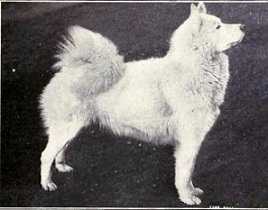Alternative Names: Sammy
Country of Origin: Siberia
History: The Samoyed takes its name from the Samoyed people, a nomadic tribe from the Siberian tundra. The Samoyed used the dog as a hunter, reindeer herder, and sled dog. When western polar explorers came upon the dogs in the nineteenth century and early twentieth century, they brought examples home with then, where the breed soon became popular with the English aristocracy. Shortly thereafter, the first Samoyed was imported to the U.S. It was also used in subsequent Artic exploration. The Samoyed has become a popular pet in the U.S.

Physical Description: This medium sized spitz dog has a wedge-shaped head, triangular prick ears, and dark, almond shaped eyes. The corner of the mouth turns up slightly in a smile and its nose is black, although brown, liver, or Dudley noses are not unusual. It is longer than it is tall with a long tail that curls over the back or hangs down. It has a heavy double coat that is white or biscuit colored. The undercoat is dense and soft, while the outer coat is long and coarse. There is a heavy ruff on the neck and the tail is plumed.
Height: 19 to 23.5 inches
Weight: 35 to 65 pounds
Temperament: The Samoyed is an affectionate, gentle dog that craves human interaction. It is intelligent and lively and can be mischievous. It gets along with almost everyone, including children and other dogs.
Activity Level: High
Best Owner: The Samoyed does well with an active family in the country or suburbs.
Special Needs: Attention, exercise, grooming, training
Possible Health Concerns: Bloat, cardiac problems, eye problems, hip dysplasia, renal, skin allergies




